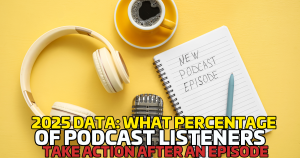The Platform Warfare of Podcasting
In 2025 the podcasting landscape is defined as much by where people listen as by what they listen to.
Platforms compete aggressively for creators, audiences, and ad revenue. Understanding market share among major platforms such as YouTube, Spotify, and
Apple Podcasts is critical for brands and professionals looking to get booked, placed, or advertised on the right channels.
In this article, we unpack the latest data on platform usage in 2025, highlight trends you should know, and show how this affects podcast strategy for creators and businesses. For a broader industry snapshot, also see our report Podcast Statistics 2025 and Why It Matters for Professionals, Business Owners & Advocates.
Platform Share Breakdown: Who’s Leading in 2025?
YouTube Takes the Lead for Podcast Listening
According to multiple sources, YouTube is now the most-used platform for podcast consumption among U.S. listeners.
A breakdown from April 2025 shows YouTube at roughly 39% of weekly podcast consumers in the U.S., followed by Spotify at 21% and Apple Podcasts at 8%. (backlinko.com)
Another source reports that YouTube captured 33% of U.S. podcast listener preference, followed by Spotify at 26% and Apple Podcasts at 14%. (podcastatistics.com)
This dominance is driven by video-podcast formats and hybrid audio-video consumption. For brands, this means that presence on YouTube is increasingly important, even for audio-first shows.
Spotify and Apple: Still Major but Facing Pressure
Spotify remains a major player in podcasting with a large library of titles (reports of 6.5+ million podcasts on Spotify) and strong global reach. (backlinko.com) Apple Podcasts continues to hold significance, especially for audio-only listeners and certain demographics. One report showed Apple Podcasts at 37.4% share of downloads/views among the top 250 U.S. podcasts in 2025. (podnews.net)
Nevertheless, the shift toward broader platforms like YouTube and the rise of video-enabled podcast consumption is challenging the traditional dominance of Spotify and Apple.
Smaller Platforms and the “Other” Category
Beyond the big three, other platforms like Amazon Music, Pandora, and proprietary apps for brands still capture meaningful share.
A 2025 breakdown shows “Others” accounting for roughly 25% to 30% of listener preference globally. (demandsage.com) These smaller platforms often serve niche audiences or local markets and can offer high-value placement for targeted brand strategies.
Why Market Share Matters for Brands & Creators
Understanding platform share is not just academic. It drives real decision-making around where you publish, how you promote, and which audience you reach.
- Discoverability and reach: If YouTube leads in audience usage, then having your show there (or a clip of it) increases chances of discovery, especially among non-traditional podcast listeners.
- Audience type and format: Platforms attract different listener behaviors. YouTube may skew toward video-podcast watchers and younger audiences, while Spotify and Apple may serve more audio-only, dedicated listeners.
- Monetization and partnerships: Advertising rates, sponsorship opportunities, and creator revenue vary by platform. If a platform is growing fast, its CPMs and ROI potential may be higher.
- Content format strategy: Given YouTube’s dominance, brands may choose to publish video versions, highlight clips, and optimize for visual search, even for audio-first content.
Key Trends to Watch in 2025
Growth of Video Podcast Formats
The rise of video podcasts is a major shift. Many listeners now prefer video or hybrid formats, giving platforms like YouTube a structural advantage. One report notes that 42% of U.S. adults prefer podcasts with video elements. (emarketer.com)
Brands producing video-enabled podcasts can leverage visual engagement, clips for social media, and higher reach via YouTube or apps that support video.
Global Expansion and Platform Diversification
While U.S. data is rich, globally the landscape is more fragmented.
For example, reports show Spotify as the favorite globally at about 37% of listeners, Apple at about 33% in certain markets, with YouTube strong everywhere. (demandsage.com) For brands planning international presence, it is crucial to account for regional platform preferences.
Shift From Audio-Only to Multimedia
Platforms that started as audio-only are increasingly supporting video, live streams, and interactive formats.
This means creators and brands must think beyond audio. Publishing across multiple platforms (app, desktop, TV) helps maximize listening share.
Platform Strategy: What Brands Should Do
1. Publish Across Platforms
Don’t rely on a single platform. Make sure your podcast is available on Apple Podcasts, Spotify, and also upload a version or clip to YouTube.
This maximizes reach and aligns with how listeners discover content.
2. Optimize for Platform Behavior
Tailor content for each platform. For YouTube, publish with video, chapters, visuals, and SEO-friendly titles. For Spotify and Apple, focus on audio quality, show notes, and engagement features.
3. Promote Where Your Audience Lives
Use platform data to know where your target listeners are. If you are targeting younger, video-oriented listeners, focus on YouTube.
If you serve professionals who listen while commuting, audio apps may be stronger.
4. Leverage Clips and Social Media
Since platforms like YouTube reward clips and discoverability, cut your episodes into shareable segments, repurpose for social media, and create teasers.
This helps reach new listeners and build your brand.
5. Measure Platform-Specific Metrics
Track where listeners come from, what devices they use, and how they engage on each platform.
Platform share metrics influence how you allocate resources, choose guests, and build your podcast mission.
Challenges and Considerations
- Platform churn and algorithm change: A platform dominating today might change tomorrow. YouTube’s lead may shift, so stay adaptable.
- Discoverability in smaller platforms: Just because a platform has less global share does not mean it has no value. Niche platforms may offer high engagement and targeted listeners.
- Production costs for video: If you lean into platforms like YouTube, video production raises the bar and costs. Evaluate ROI carefully.
- Monetization complexity: Different platforms have different ad models, subscription features, and creator policies. Understand them before scaling.
Platform Share Shapes Your Podcast Strategy
In 2025, platform market share is a foundational part of podcast strategy. Platforms like YouTube, Spotify, and Apple Podcasts each carry different strengths, audiences, and format expectations.
For brands, thought leaders, and professionals wanting to win in audio content, there is no one-size-fits-all. Strategic publication, platform-specific optimization, and audience-first thinking are key.
At Command Your Brand, we help clients understand exactly which platforms matter for their message, audience, and objectives, and then build campaigns that match the data and the format.
Ready to make sure your podcast shows up on the platforms that matter and reaches the listeners who engage? Book a strategy call with Command Your Brand today.
And don’t forget to explore the broader context of the podcast industry in our foundational piece: Podcast Statistics 2025 and Why It Matters for Professionals, Business Owners & Advocates.




